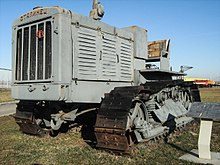Vender
| Vender | |
|---|---|
| legal form | |
| resolution | 1959 |
| Reason for dissolution | Takeover by Allis-Chalmers |
| Seat |
|
| Branch | Vehicle construction , mechanical engineering |
Vender was an Italian construction machinery manufacturer best known for its crawler tractors .
Company history
Since 1906 at the latest, Luigi Vender ran a factory for agricultural machines in Milan. At the end of the 1930s, Pietro Pensa (1906–1996) became chief designer in this company, and the numerous caterpillar tractor designs go back to him. The production of tractors has always been relatively modest, complaints have been made about the poor reliability of the products. In 1959, the American company Allis-Chalmers bought Vender in order to gain a foothold in Europe, and in the following years the brand name Vender disappeared: the new owner limited himself to assembling and manufacturing his own products under license.
vehicles
During the Abyssinian War , Italy had already obtained numerous Caterpillar branded chain tractors from the USA and thus ensured supplies for its troops in the partially roadless Ethiopia. Similar experiences were made in Russia in 1941/42, with the Italians being able to fall back on captured Russian caterpillar tractors Stalinez-60 and Stalinez-65 . As a result, the companies Vender and Savigliano received the order to develop heavy crawler tractors during World War II . All models built by Vender had their own in-line diesel engines developed by Vender and - unless otherwise noted - track drives .
DR 90

The DR 90 crawler tractor was developed during World War II and went into series production in 1944. Its engine and chassis were based on the Caterpillar RD-7 or Stalinez-65 crawler tractor (the Stalinez-65 is a copy of the Caterpillar RD-7 with a diesel engine). It had a four-cylinder engine with a 145 mm bore and 200 mm stroke, from which a displacement of 13,200 cm³ was calculated, and developed 85 hp (62 kW), later also 110 hp (81 kW). The transmission had 5 forward and 5 reverse gears. 109 vehicles were built in 1944, and after May 1945 to 1948 another 81 units.
SR 45
The SR 45 was created in 1945 as a lighter tug because it was assumed that a heavy vehicle like the DR 90 would be oversized in peacetime. It had the halved engine of the DR 90, which made 55 HP (40 kW) with 2 cylinders at 6600 cm³. Between 1945 and 1948, 85 pieces were made.
DR 70
It was developed as the successor to the SR 45 and had a four-cylinder engine better suited to the vehicle (115 mm bore, 160 mm stroke = 6650 cm³), the power of which is specified as 70 HP (51 kW). 68 pieces were made between 1948 and 1950.
champion
The champion was the successor to the DR 70. The bore was increased to 125 mm, the engine had a displacement of 7850 cm³ and developed 72 hp (53 kW). From 1950 to 1954, 243 pieces of the B model were produced, and 205 pieces of the slightly improved C model from 1954 to 1956.
Conqueror
The Conqueror was created as a heavy chain tractor in 1954: the six-cylinder engine with a 145 mm bore and 170 mm stroke (16,830 cm³) developed 140 hp (103 kW) at 1350 rpm, the transmission with 5 forward and 5 reverse gears allowed speeds of 2.5 up to 9.7 km / h. With a length of 4.72 m and a width of 2.57 m, the vehicle weighed 15.7 tons. By 1957, 18 vehicles had been built, 11 of them with output reduced to 125 hp. In 1954 the tug cost 15,625,000 lire (then around 100,000 DM).
Destrojer
The Destrojer (also called Destructore), built in 1953, is considered to be the largest caterpillar tractor of its time, it probably remained a one-off. Its six-cylinder engine (172 mm bore, 175 mm stroke = 24,397 cm³) developed 240 PS (176 kW) at 1350 rpm, 4 forward and 4 reverse gears each allowed speeds of 2.6 to 12 km / h, which was around 5 m long and 3 m wide vehicle weighed 23 tons.
Bully C
The small Bully, built from 1954 to 1957, was not a great success. Its four-cylinder engine (115 mm bore, 120 mm stroke, 4985 cm³) developed 50 hp (37 kW) at 1500 rpm. The vehicle had 8 forward and two reverse gears, was 3 m long and 1.79 m wide and weighed 4.72 tons. 254 vehicles were built. The company advertised that the crawler undercarriage could be exchanged for a wheeled undercarriage within 4 hours, 22 pieces of a corresponding kit were delivered.
literature
- Dozza, William: Trattori Classici Italiani dal 1911 al 1955 . Vimodrone (Milano) 2007, ISBN 978-88-7911-321-2 .
- Pignato, Nicola / Cappellano, Filippo: Gli autoveicoli tattici e logisrici del Regio Esercito Italiano fino al 1943 . tomo secondo, Roma 2005.
Individual evidence
- ↑ a b c d e f Dozza, William: Trattori Classici Italiani dal 1911 al 1955 . P. 192.
- ↑ Pignato, Nicola / Cappellano, Filippo: Gli autoveicoli tattici e logisrici del Regio Italian Army fino al 1943 . P. 426.
- ↑ Federal Archives, files BA R 3176.
- ^ Dozza, William: Trattori Classici Italiani dal 1911 al 1955 . P. 191.
- ^ Dozza, William: Trattori Classici Italiani dal 1911 al 1955 . P. 192 f.